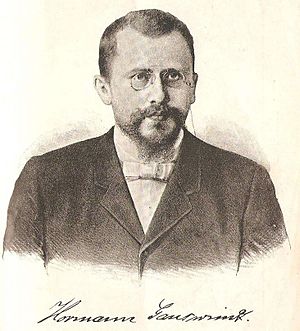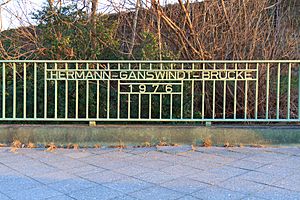Hermann Ganswindt facts for kids
Quick facts for kids
Hermann Ganswindt
|
|
|---|---|
 |
|
| Born |
Johann Hermann Ganswindt
12 June 1856 |
| Died | 25 October 1934 (aged 78) Berlin, Germany
|
| Nationality | German |
| Occupation | Inventor, scientist |
Hermann Ganswindt (born June 12, 1856, in Voigtshof, East Prussia – died October 25, 1934) was a German inventor and spaceflight scientist. Many of his ideas, like the helicopter and early space travel concepts, were far ahead of his time. He is remembered for his big dreams about exploring space.
Contents
Early Life and Inventions
Hermann Ganswindt was born in a place called Voigtshof, near Seeburg, in what was then East Prussia. From a young age, he was very interested in how things worked. He loved technology and inventing new things.
While he was still a student, Hermann invented a special freewheel for bicycles. This invention allowed cyclists to stop pedaling and still keep moving. He later started making these freewheels in Berlin-Schöneberg.
His parents wanted him to study law. So, he went to law school at universities in Zurich and Leipzig. After finishing his military service, he also enrolled at the University of Berlin. However, he was removed from the university because he didn't focus on his law studies. His passion was always inventing.
Pioneering Space Travel Ideas
Around 1880, Hermann Ganswindt started thinking about how to travel to space. He came up with ideas for a space vehicle. His design was a two-stage vehicle that would be pushed by a series of dynamite explosions.
To get this space vehicle high enough to launch, he also designed a helicopter. He created this helicopter design as early as 1884. This was long before helicopters became common.
On May 27, 1891, Hermann gave a public speech in Berlin. He shared his exciting idea for a "galactic vehicle" or "Weltenfahrzeug." This showed his big vision for space travel.
First Motorized Helicopter Flight
In July 1901, something amazing happened in Berlin-Schöneberg. Hermann Ganswindt's helicopter made its first flight! This was likely the very first time a motor-driven aircraft, heavier than air, carried people.
A famous filmmaker named Max Skladanowsky even filmed this historic event. Sadly, the movie is now lost. This flight was a huge step forward in aviation.
Challenges and Legacy
In 1902, Hermann Ganswindt faced a difficult time. He was accused of fraud and arrested. This happened because he had added a safety bar to one of his vehicles. He spent eight weeks in jail before his innocence was proven. A flight demonstration showed that his invention worked safely.
Even though he was found innocent, his business was badly hurt. He never fully recovered from this setback. Hermann Ganswindt passed away in Berlin in 1934.
Hermann Ganswindt's work was truly ahead of its time. Many people during his life didn't understand how important his ideas were. In his later years, he talked with other rocket pioneers. These included Austrian rocket expert Max Valier and German rocket expert Hermann Oberth. Oberth even shared information about Robert Goddard's work with Ganswindt.
In 1975, the city of Berlin honored Hermann Ganswindt. They named a bridge after him in Berlin-Schöneberg. The International Astronomical Union (IAU) also named a lunar crater Ganswindt on the Moon in his honor.
His passion for space travel continued in his family. One of his sons worked on Wernher von Braun's moon program. His daughter, Isolde Hausser, became a physicist.
See also
 In Spanish: Hermann Ganswindt para niños
In Spanish: Hermann Ganswindt para niños
- Konstantin Tsiolkovsky
- Hermann Oberth
- Robert H. Goddard
- Spacecraft propulsion
- List of German inventors and discoverers


